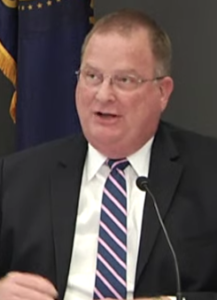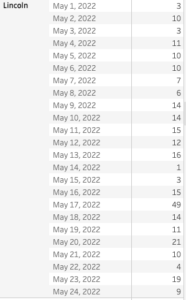
By QUINTON SMITH/YachatsNews.com and LYNNE TERRY/Oregon Capital Chronicle
The number of Covid cases in Lincoln County is surging again but because of the area’s high vaccination rate, new treatments and a less virulent variety of the disease, hospitalizations have been minimal.
Lincoln County Public Health said it had official reports of 381 Covid cases in May – equal to the number of monthly cases last October, November and December. But there was no one in the county’s two hospitals last week who tested positive or were being treated for the disease, said Susan Trachsel, LCPH spokeswoman.
“We know it’s out there, but there’s been no hospitalizations,” Trachsel said.
However, Oregon health officials believe the number of reported cases is likely just a fraction of actual cases. That’s because of the proliferation of free at-home “rapid” tests and that few people who self-test report their positive results to public health agencies.

Patrick Allen, the director of the Oregon Health Authority, told a legislative committee Friday that his agency might be hearing of only one-tenth of cases statewide.
And while Covid continues to sicken hundreds of people every day in Oregon, Allen said fewer people are being hospitalized and much fewer need intensive care.
“Unlike every other past surge, we are not seeing significant increases of people in the ICU and especially (on) ventilators,” Allen told the House Interim Special Committee on Covid-19 Response.
On Thursday, there were only six people statewide on ventilators, he said.
Peter Graven, the lead Covid forecaster at Oregon Health Sciences University, said the number of people reporting Covid symptoms in Oregon is relatively high compared with the rest of the country. The current surge, fueled by the variant BA.2, hit the East Coast first.
Graven expects hospitalizations to peak at 313 on June 14 and then subside. His calculations show a relatively low level of new infections by August.

In Lincoln County, Covid cases peaked in January when 2,050 were reported, then dropped to 880 in February and 88 in March – when in-home tests became widely available.
The relative weakness of the current Covid variant combined with Lincoln County’s high vaccination rate – the third highest in Oregon — is credited with helping keep hospitalizations low.
In Lincoln County, 87.7 percent of people over the age of five have received at least one vaccine dose. More than 65 percent of all residents have had at least one booster shot.
The vaccination rate around the county ranges from 99 percent in the Yachats zip code, to 80.6 percent in the Waldport zip code, to 75 percent in the South Beach zip code, according to OHA data.
Newport and Lincoln City are participating in a wastewater monitoring program by the OHA and Oregon State University. The latest tests show increases or “sustained” increases in detection of the Covid virus in wastewater samples in both cities.
The test positivity rate – a measure of how easily the coronavirus can spread through a community – hit 22.4 percent last week in Lincoln County – the same level as during the big surge in January, Trachsel said. A positivity rate of less than 5 percent means the virus is having trouble spreading. The rate had dropped to 2.2 percent in late March.
Lincoln County is among 30 of 36 counties in Oregon which has positivity rates higher than 10 percent. That “high” rating means health officials recommend people get booster shots and wear face masks “indoors or where there is not good ventilation,” Trachsel said.
Vaccinations, treatments lower hospitalizations
Another change that is leading to fewer serious illnesses is the availability of Covid treatments.
Providers can prescribe three antivirals to disrupt the viral cycle or prevent the virus from multiplying, according to Dr. Dean Sidelinger, state epidemiologist. There also are two infusions to prevent severe disease or to prevent someone from getting Covid.
The virus continues to spread in Oregon, but the number of new illnesses reported each day are no longer increasing by 50 percent as they were a few weeks ago, Allen said.
More than 4 percent of people who seek treatment in an emergency room have Covid-like symptoms, which Allen said is relatively high.
While cases of severe illness are not spiking, long Covid continues to affect hundreds of thousands of Oregonians, according to Dr. Eric Herman, OHSU’s chief primary care and population health officer. A person is considered to have long Covid when symptoms persist four or more weeks after the initial infection.
Herman told the legislative committee last week that up to 24 million people in the U.S. have or have had long Covid out of 80 million infections. Long Covid cases in Oregon could be as high as 230,000 people. So far, more than 765,000 Oregonians have tested positive.
Long Covid affects all ages, but women between 35 and 69, minority communities and people with chronic conditions like diabetes face the highest risk.
The disease can be caused by a dysfunctional immune response, inflammation, clotting or other problems. Symptoms include fatigue, memory and problem-solving problems, joint and muscle pain, sleep troubles and headaches, Herman said. Recovery can take weeks, months or even years.
A new vaccine for children aged 6 months through 4 years is expected to be available in about three weeks. But Allen said the state does not expect a surge of interest.
“We’re really running out of people who want to get vaccinated,” Allen told the committee.
- Oregon Capital Chronicle is a nonprofit Salem-based news service that focuses its reporting on Oregon state government, politics and policy.


